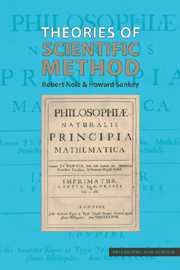Book contents
- Frontmatter
- Contents
- Abbreviations
- Acknowledgements
- Introduction
- I The idea of methodology
- II Inductive and hypothetico-deductive methods
- III Probability and scientific method
- 8 Probability, Bayesianism and methodology
- 9 Bayesianism: applications and problems
- IV Popper and his rivals
- V Naturalism, pragmatism, realism and methodology
- Epilogue
- Notes
- Bibliography
- Index
8 - Probability, Bayesianism and methodology
from III - Probability and scientific method
- Frontmatter
- Contents
- Abbreviations
- Acknowledgements
- Introduction
- I The idea of methodology
- II Inductive and hypothetico-deductive methods
- III Probability and scientific method
- 8 Probability, Bayesianism and methodology
- 9 Bayesianism: applications and problems
- IV Popper and his rivals
- V Naturalism, pragmatism, realism and methodology
- Epilogue
- Notes
- Bibliography
- Index
Summary
The theory of probabilistic inference has come to occupy a prominent place in methodology. Over the past fifty years subjective Bayesianism has been regarded (by many but not all) as the leading theory of scientific method. Here and in Chapter 9 we set out what this theory is, how it comes to encompass many of the aspects of method explored elsewhere in this book and what its strengths and weaknesses may be. Section 8.1 sets out the axioms of probability along with some of their more important consequences. These lead quite naturally to Bayes's theorem, a result discovered by the eighteenth-century cleric Thomas Bayes, which is central to all probabilistic thinking. The theorem comes in many different forms several of which are mentioned in §8.2 in order to bring out the different ways in which it can be applied. Once this is set out it is possible to outline a theory of the confirmation of a hypothesis by evidence (§8.3). In §8.4 it is shown that the h-d method can be placed in this setting; its good aspects turn out to be special cases of Bayes's theorem. This setting also provides a theory of confirmation for the h-d method, something that it lacks.
- Type
- Chapter
- Information
- Theories of Scientific MethodAn Introduction, pp. 186 - 219Publisher: Acumen PublishingPrint publication year: 2007



